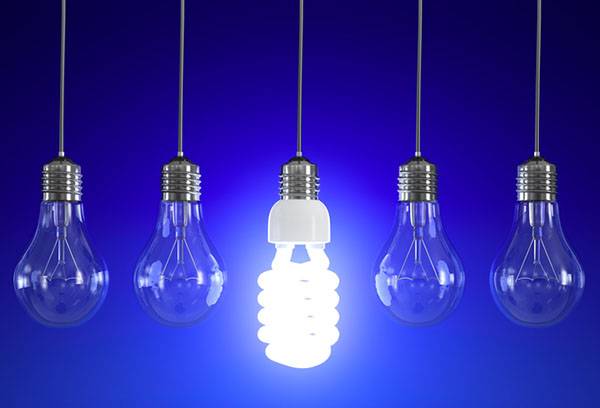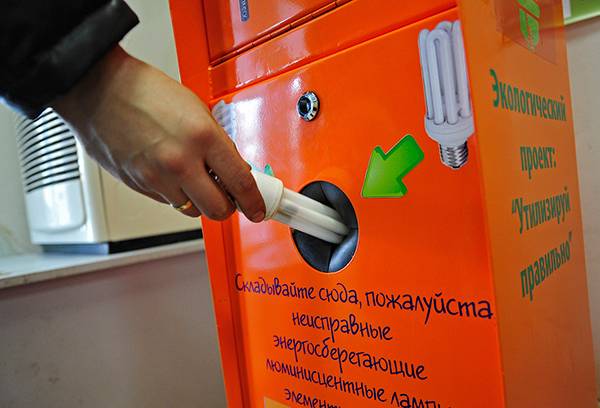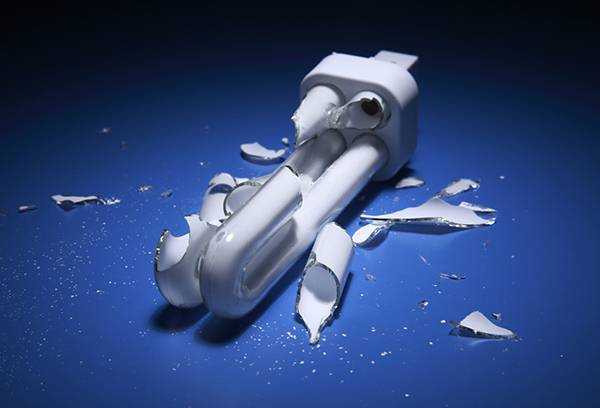Where can I get energy-saving bulbs that have served their time?
Content:
Almost every family has modern energy-saving light bulbs. However, few think about the need for proper disposal of waste fluorescent lamps. However, according to studies, these industrial wastes can harm the human body, so after using them you should not throw them in the trash.
Why are energy-saving light bulbs harmful?
Energy-saving light bulbs are very practical, so they are widely used almost everywhere. But few think that these seemingly harmless devices can carry a serious danger. It's all about ultraviolet radiation, which comes from this type of light bulb in a dose that can be dangerous for skin cells. Over time, there is a risk of developing serious diseases, up to melanoma - one of the dangerous types of cancer.
Despite the fact that the manufacturers of the product claim that the dose of emitted ultraviolet is negligible, you should not take this word for it. Recent studies have confirmed that with prolonged use, microcracks form on the surface of the light bulbs that can transmit radiation, thereby harming people in the vicinity.
In addition, improper use of light bulbs can lead to hormonal changes, cause cardiovascular disease, and also lead to the development of diabetes. And it's not just about dangerous ultraviolet radiation. These devices have a high percentage of mercury, which also does not bode well. This is one of the main reasons why a used energy-saving light bulb should not be thrown away, because if it breaks, mercury vapor can cause a lot of trouble.
What to do? Does it stop using energy-saving lamps? No, you can use them. You just need to always remember the rules of personal safety, change burned-out devices in time, and never throw them into the trash bin or bins. Where to put them?
Where to take burnt out bulbs?
We have already figured out why it is impossible to throw out burned out energy-saving bulbs. But the logical question arises: how to properly dispose of industrial waste so as not to harm your health? There are several options.
So what should your actions be?
- Carefully pack burnt-out devices so that they cannot break during transport. For these purposes, you can use a cardboard box, which must first be filled with soft material, such as cloth or cotton wool. You can also wrap each light bulb in newsprint.
- With this box, you should go to the nearest point for receiving such industrial waste, where you need to turn in all the bulbs.
However, keep in mind that not all enterprises may agree to pick up used bulbs from individuals, as some exist solely for the acceptance of large quantities of industrial waste from firms, shopping centers, etc., under special agreements. Where then to turn in the bulbs?
In each city, the reception of industrial waste, as a rule, is done in the regional DEZ, as well as the REU. For this purpose, as a rule, special tanks are installed on the territory of enterprises where it is necessary to throw out fluorescent bulbs that have expired.If you did not find such a container, you should contact the administration or service personnel for help, they will show you where to send the waste.
The city’s environmental services are also required to dispose of not only energy-saving light bulbs, but also crashed mercury thermometers and other wastes that could be harmful to human health.
In addition, you can take out your old fluorescent devices on the IKEA network. This option can be used by residents of large cities in which this store is located. Since 2014, they again began to dispose of batteries, as well as light bulbs containing mercury. It is necessary to collect all the blown devices in a box, carefully pack them and hand them over to the operating personnel.
Tip
In recent years, the problem of the delivery and reception of mercury light bulbs, batteries, and other hazardous waste has become so acute that prosecutors in many cities have asked the court to install special containers with the help of HOA, where people could hand over old devices. Therefore, take an interest in your homeowners association, perhaps there are already such tanks near your home.
What to do if an energy-saving light bulb crashes?
We have already examined the question of how dangerous energy-saving bulbs can be and why their use should be treated wisely. But what if, by chance, the bulb was broken, and how to avoid the spread of mercury vapor? The main thing is not to panic, to collect your thoughts and act in the same way as in the case of thermometers.
- Close the room in which the incident occurred, do not allow draft to occur, as this helps spread mercury throughout the room.
- Open the window and ventilate the room for a day.
- Take a can, fill it with cold water, you can add a little potassium permanganate to it.
- Protect your hands by wearing rubber gloves.
- Collect all the visible remains of the crashed light bulb, including the base, in the prepared container with water.
- Small pieces are collected with a damp cloth. After that, you should remove the gloves and send them to the jar along with a rag that you used to remove the remnants of the broken lamp.
- Close the container tightly and take it to the industrial waste collection point, where you need to hand over the jar along with all the devices that were used in the cleaning process.
When using fluorescent lamps, be extremely careful. They are convenient and practical, but can cause serious harm to your body if used improperly. Therefore, always remember that you can’t dispose of your old device in regular trash bins.
All blown bulbs must be disposed of in a timely manner, for this you need to properly pack them and turn them in. At the same time, be careful that the devices do not crash, otherwise mercury vapor can harm your health and those around you. It is advisable to ask in advance where you can rent bulbs nearby.


